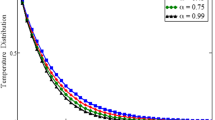Abstract
It is important to completely understand heat/mass transfer from a flat plate because it is a basic element of heat/mass transfer. In the present study, local heat/mass transfer coefficient is obtained for two flow conditions to investigate the effect of boundary layer using the naphthalene sublimation technique. Obtained local heat/mass transfer coefficient is converted to dimensionless parameters such as Sherwood number, Stanton number and Colburnj-factor. These also are compared with correlations of laminar and turbulent heat/mass transfer from a flat plate. According to experimental results, local Sherwood number and local Stanton number are in much better agreement with the correlation of turbulent region rather than laminar region, which means analogy between heat/mass transfer and momentum transfer is more suitable for turbulent boundary layer. But average Sherwood number and average Colburnj-factor representing analogy between heat/mass transfer and momentum transfer are consistent with the correlation of laminar boundary layer as well as turbulent boundary layer.
Similar content being viewed by others
Abbreviations
- Cf :
-
Skin friction coefficient, (dimensionless)
- Cf,l :
-
Average skin friction coefficient at x=L, (dimensionless)
- Cf,x :
-
Local skin friction coefficient, (dimensionless)
- Diff :
-
Mass diffusion coefficient of naphthalene in the air, (m2/sec)
- h:
-
Heat transfer coefficient, (W/m2k)
- hm :
-
Mass transfer coefficient, (m/sec)
- jH :
-
Colburn j factor for heat transfer
- jm :
-
Colburn j factor for mass transfer
- L:
-
Distance from leading edge to last measured point location in flow direction, (m)
- Nu:
-
Nusselt number, (dimensionless)
- Pv,w :
-
Vapor pressure of naphthalene, (Pa)
- Pr:
-
Prandtl number, (dimensionless)
- Rex :
-
Reynolds number based on distance from leading edge, (dimensionless)
- ReL :
-
Reynolds number at x = L
- ReL=2oomm :
-
Reynolds number based on distance from leading edge to x=200 mm
- Sc:
-
Schmidt number, (dimensionless)
- Sh:
-
Sherwood number, (dimensionless)
- ShL :
-
average Sherwood number at x=L (dimensionless)
- Shx :
-
Sherwood number based on distance from the leading edge (dimensionless)
- St:
-
Stanton number for heat transfer, (dimensionless)
- Stm :
-
Stanton number for mass transfer, (dimensionless)
- Stx :
-
Stanton number for heat transfer based on the distance from the leading edge,(dimensionless)
- Stm,x :
-
Stanton number for mass transfer based on the distance from the leading edge (dimensionless)
- T:
-
Temperature, (K)
- Δt:
-
Sublimation depth, (m)
- u∞ :
-
Free stream air velocity, (m/s)
- δ:
-
Momentum boundary layer thickness
- δM :
-
Mass concentration boundary layer thickness
- δT :
-
Thermal boundary layer thickness
- ρs :
-
Density of solid naphthalene, (kg/m3)
- δv,w :
-
Density of naphthalene vapor, (kg/m3)
- Δτ:
-
Run time in wind tunnel, (sec)
References
Ambrose, D., Lawrenson, I. J. and Sparke, C. H. S., 1975, “The Vapor Pressure of Naphthalene,”J. Chem. Thermodynam., Vol. 7, pp. 1173–1176.
Cho, K. 1989, “Measurement of the Diffusion Coefficient of Naphthalene into Air,”Ph.D. Dissertation, State Univ. of NY.
Goldstein, R. J., Karni, J. and Zhu, Y., 1990, “Effects of Boundary Conditions Layer on Mass Transfer near the Base of a Cylinder in Crossflow,”J, of Heat Transfer, Vol. 112, pp. 501–504.
Incropera, F. R. and Dewitt, D. P., 1996,Fundamentals of Heat and Mass Transfer, 4th Ed. Wiley, pp. 348,–358.
Kays, W. M., and Crawford, M. E., 1993,Convective Heat and Mass Transfer, 3rd Ed., Mcgraw-Hill Inc., pp. 192–222.
Kline, S. J. and McClintock, FA., 1953, “Describing Uncertainty in Single-sample Experiments,”Mech. Eng., Vol. 75, pp. 3–8.
Park, J. H., 2003, “An Experimental Study on the Heat/Mass Transfer Characteristics from a Flat Palte and a Corrugated Plate,”Ph.D. Dissertation, Chungnam National Univ.
Schlichting, H., 1979,Boundary Layer Theory, 7th Ed. Mcgraw-Hill Inc. pp. 636–647.
Yoo, S. Y., No, J. K. and Chung, C. H., Chung, M. K., 1993, “A Study on the Analogy between Heat Transfer and Mass Transfer,”Transaction of KSME (B), Vol. 17. No. 10, pp. 2624–2633.
Yoo, S. Y., Park, J. H. and Chung, C. H., Chung, M. K., 2003, “An Experimental Study on Heat/Mass Transfer from a Rectangular Cylinder,”J. of Heat Transfer, Vol. 125, pp. 1163–1169.
Author information
Authors and Affiliations
Corresponding author
Rights and permissions
About this article
Cite this article
Park, JH., Yoo, SY. A naphthalene sublimation study on heat/mass transfer for flow over a flat plate. KSME International Journal 18, 1258–1266 (2004). https://doi.org/10.1007/BF02983300
Received:
Revised:
Published:
Issue Date:
DOI: https://doi.org/10.1007/BF02983300




